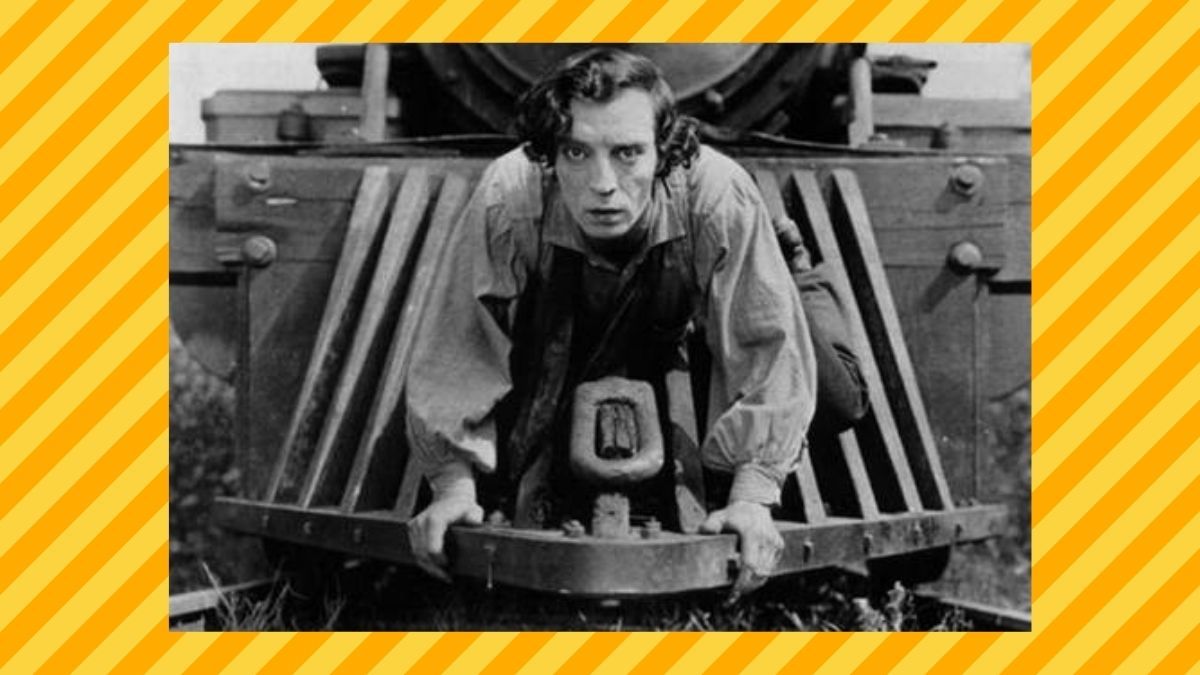In 1926, audiences were amazed by the daredevil antics of comedian Buster Keaton in the movie "The General." Nearly 100 years later, Keaton's performance in the movie is still drawing "oohs" and "aahs," as clips from this famous silent film circulate on social media.
The following clip went viral in June 2021 and shows Keaton removing a set of broken train ties from a track while sitting aboard a moving train:
This is a genuine clip from the movie "The General" and this is a real stunt that was performed by Keaton.
Keaton, like many performers of his day, performed many of his own stunts. And since computer generated effects weren't exactly widespread in 1926 (or computers at all for that matter), many of the stunts you saw on screen were genuine, as film critic Roger Ebert noted in his 1997 review of "The General":
One inspiration builds into another: To shield himself from the cannonball, he runs forward and sits on the cowcatcher of the speeding Texas, with no one at the controls and a big railroad tie in his arms. The Union men throw another tie onto the tracks, and Keaton, with perfect aim and timing, knocks the second off by throwing the first. It's flawless and perfect, but consider how risky it is to sit on the front of a locomotive hoping one tie will knock another out of the way without either one smashing your brains out.
[...]
Today I look at Keaton's works more often than any other silent films. They have such a graceful perfection, such a meshing of story, character and episode, that they unfold like music. Although they're filled with gags, you can rarely catch Keaton writing a scene around a gag; instead, the laughs emerge from the situation; he was “the still, small, suffering center of the hysteria of slapstick,” wrote the critic Karen Jaehne. And in an age when special effects were in their infancy, and a “stunt” often meant actually doing on the screen what you appeared to be doing, Keaton was ambitious and fearless. He had a house collapse around him. He swung over a waterfall to rescue a woman he loved. He fell from trains. And always he did it in character, playing a solemn and thoughtful man who trusts in his own ingenuity.
While digital effects were certainly unavailable in the 1920s, there were other ways to "trick" the viewer. Keaton could have used close-ups or quick cuts to make it look as if he was truly clearing railroad ties from the the front of a train. Keaton, however, preferred to use long shots that showed his full body and uninterrupted cuts so that his audience would know that he was truly performing these stunts.
Here's an excerpt from a book of interviews with Keaton that was published in 2007:
Keaton himself did his stunt work, magically and beautifully. Who else? He could loop through the air like a lasso. When he is playing the cox in "College" and the tiller falls off the boat, it is entirely in character that he should dip himself into the water and use his own body as the tiller. The end of "Seven Chances" is an amazing piece of stunt invention, inspired by cascades of falling boulders, that would have killed Keaton if he hadn't been an acrobat. Most of his stunt stuff isn't the sort of thing that can be retaken, and Keaton doesn't care much for inserts.
"I like long takes, in long shot," [Keaton] says. "Close-ups hurt comedy. I like to work full figure. All comedians want their feet in."
In addition to performing his own stunts, Keaton would also occasional act as the stunt double for other actors. Keaton, for example, said that he performed the stunt in "Sherlock Jr." where a police officer falls off a motorcycle.
Keaton said: "I didn't use stunt men for me, but I doubled them. There's a scene in Sherlock Jr. when I call a motorcycle cop, and I say, "follow that car." And I jump on his handlebars, we hit a bump in the street, and I lose the cop. Well, the cop that fell off was me. Because what I did was take Ernie Orsaiit, an assistant prop man with me, who was my size. Put my clothes on him. I put the cop's clothes on, drove the motorcycle hit the bump and fell off the motorcycle."
Unlike the viral train clip above, the following scene includes multiple cuts that show the characters from different angles. This allows Keaton to make it appear to the viewer that the actor playing the cop fell off the motorcycle, but in reality it was Keaton in the cop's clothing.
The clip from "The General" truly shows Keaton riding on the front of a train as he clears off railroad ties. However, we can't be certain that there wasn't some movie magic at play. For example, we'd guess (although we haven't been able to find any record of this) that the railroad ties used in this scene purposefully manufactured for the movie to be lighter than real railroad ties.
You can watch "The General" in its entirety below.

